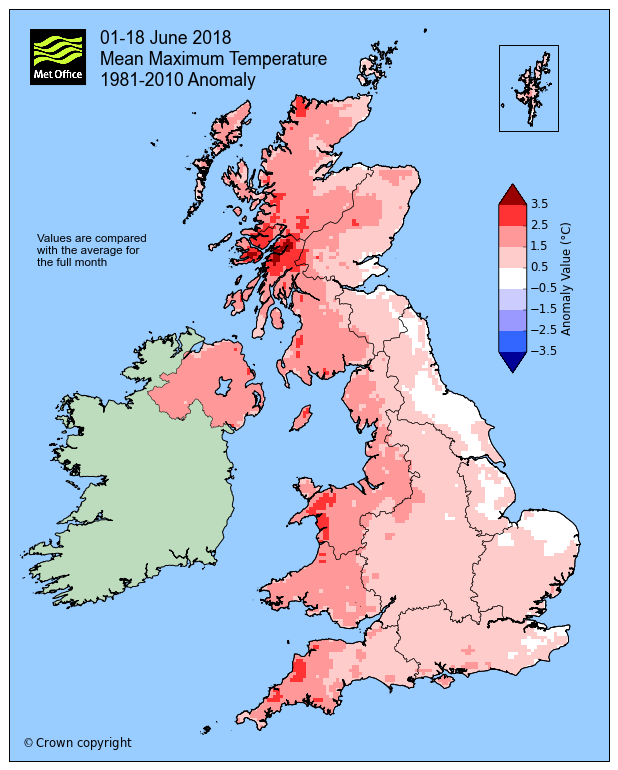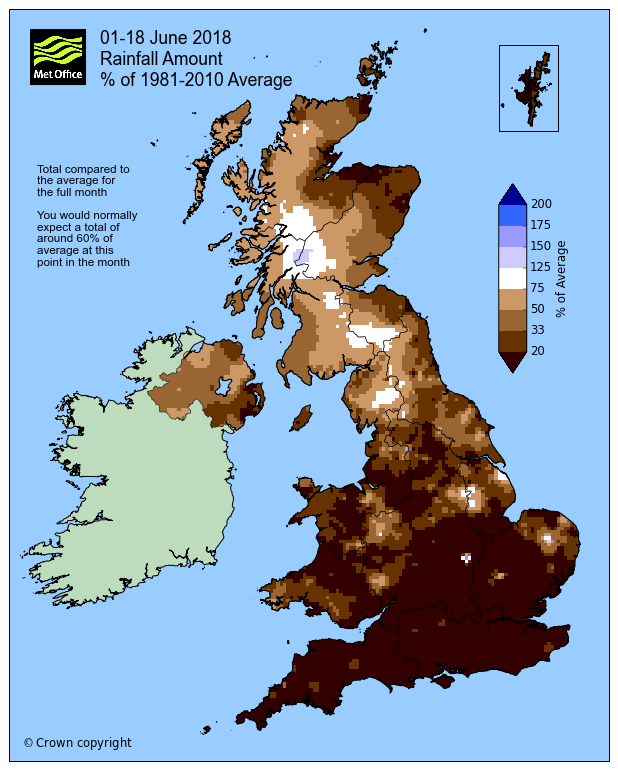As we reach the mid-point in June, statistics for the UK as a whole show that the weather has been warm and dry for many with temperatures over 1 degree above average so far and rainfall just 33% of the whole month’s average total. This follows on from what was, for many, a dry and warm May.

Max temperature for June 2018 so far compared to monthly average
However, the UK-wide statistics hide some regional variations, with Central, Southern and South East England having had just 2mm of rainfall (1 to 16 June) – 5% of the June average, while western Scotland has had 55mm (1 to 16 June) – 51% of the June average.
Some of the driest counties in southern areas of the UK include Essex, which has only received 1.4 mm of rainfall, 3% of the month’s average, Dorset, which has had 1.2mm of rain, 2% of the month’s average, and Buckinghamshire, which has had 2.1mm of rain, 4% of the month’s average. Without further rainfall this month, some southern counties could see one of the driest Junes on record.
Conversely, Western Scotland has seen above average rainfall with Argyllshire having received 76mm so far this month – 64% of the June average, Dumfriesshire has received 57mm – 66% of the June average, and Stirlingshire has received 62mm – 67% of the June average.

Rainfall for June 2018 so far compared to monthly average
While temperatures overall this month so far have been above average there have also been some regional differences, with the east side of the country generally being nearer average, for example Lincolnshire and Kent are so far just 0.4 °C above the average maximum. However, the west side of the UK has seen higher temperatures with areas such as Cornwall and Cardiganshire being 2 °C above the average maximum so far this month.
Looking back at the rainfall figures for spring it was north-western areas that were the driest, with only around half the season’s average, the reverse of rainfall amounts so far this month. It was however a rather wet spring in most eastern, central and southern areas, with rainfall 50% above normal in the wettest places.
The latest figures from UK water companies show that following the spring rainfall the water resources outlook remains healthy for the summer particularly in the south and east, a significant transformation from the situation at the start of 2018.
The Environment Agency is continuing to urge us all to think carefully about our water consumption saying the average person in England uses 140 litres per day. They published a recent report examining water resources.
Paul Hickey, Environment Agency Deputy Director of water resources said:
“At the start of June for most areas of England, the river flows, groundwater levels and soils were normal for the time of year. This followed the rain in early spring, which helped groundwaters in the south east to recover from previously low levels. During dry spells, it is not unusual for some rivers and lakes in faster responding catchments to drop quickly, but they tend to recover quickly when the rain returns. The Environment Agency continues to work with water companies, businesses and farmers to provide advice, helping to balance the needs of water users and minimise impacts on the environment of any dry weather.”
As we look at the rest of June, the forecast shows high pressure building across the south of the UK later this week with indications this will last into next week as well – meaning dry settled conditions for the south. Further north, the weather looks more unsettled with a chance of rain or showers.

So pleased to see that you’re featuring once more this sort of summary of data so far for the month,
best wishes
Julian
The sunshine figures seem to have been someway awry for Nottingham Watnall this month, with recent mornings where both the Satellite images and local webcams show sky conditions to be clear. The 22nd for example was a completely clear day, but no sunshine was logged between 8.40am and shortly before midday, as per the hourly updates on the weathercast website. Again today, while it seems to be logging sun again by mid morning, conditions have been clear all morning and yet it looks as though no sun was registered between around half 8 and half 10. So far this month (to the 24th) Nottingham has registered just 77 hours of sun, compared to Waddington with 131 hours and Sheffield with 142.5 hours. My estimates lead me to believe the actual difference is nearer a 15-20 hour deficit at Watnall compared to Waddington, not 60+ hours.
Perhaps the Met office or relevant overseeing body can check on the state of the Sun recording instruments at the observation site at Watnall?
Hi Nic
Thanks for your feedback, I’ll pass it onto our Watnall and observations teams.
Helen
Hi Nic
I followed up with our Watnall team and it seems they have some interesting rural observation challenges. The office is situated next to a field of allotments which results in many birds in the area perching on the sunshine sensor. When they fly off they often leave their ‘business’ on the sensor, which obviously requires regular checking and cleaning as a result. Unfortunately as the office is not manned every day there will be some days when it doesn’t get cleaned.
Also, people have bonfires on their allotments which can result in thick smoke coming across the enclosure and thus blocking out sunshine.
I imagine we may need to invest in some bird scarers!
Helen